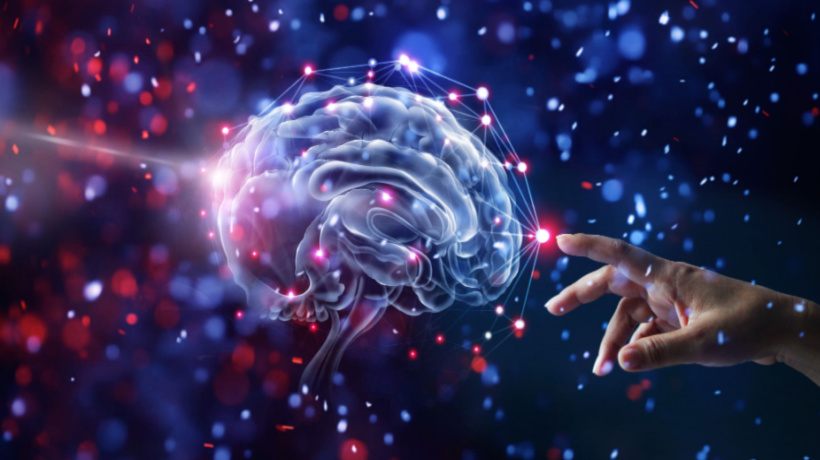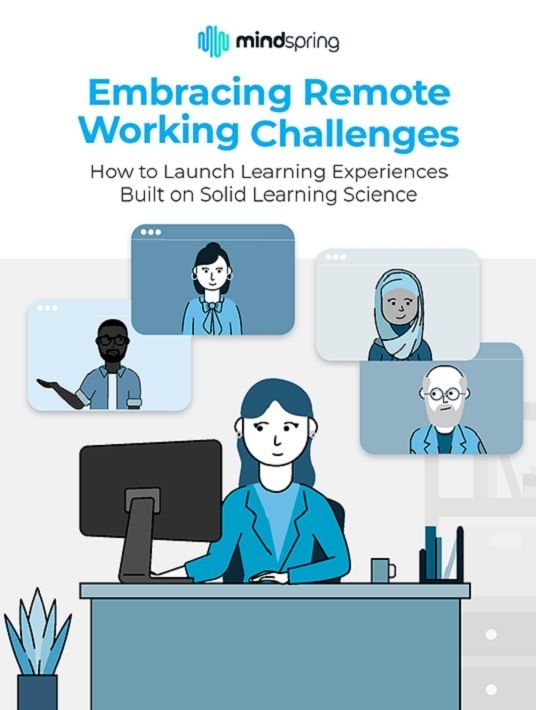
Where Learning Science Meets Instructional Design
This article is part of a series on overcoming remote working challenges by building learning experiences that are based on solid learning science. What you are about to read is a fable. The company, AshCom, is fictional, but the learning challenges faced by Kathryn, AshCom’s CLO, and her team are real and commonly shared by learning teams in large organizations. It is our hope that you will be able to connect with the characters, their challenges, and the solutions they discover. We also invite you to read the first eBook in the series.

eBook Release
Embracing Remote Working Challenges: How To Launch Learning Experiences Built On Solid Learning Science
Flexibility is key, but does the time-tested learning science support virtual learning experiences designed exclusively for remote positions?
The CLO
Not many people on AshCom’s current learning team were aware that at one point Maggie had been encouraged to apply for the job of Chief Learning Officer (CLO). The request made sense. Maggie had been at AshCom longer than most. Over 20 years ago, she joined the company in the human resources department. As AshCom grew, the leadership realized they needed a team dedicated to learning. Their products were becoming more complex, as were the processes needed to manufacture them.
Maggie’s university degree was in human resources, but she naturally gravitated toward learning. AshCom paid her tuition so that she could achieve a Master’s degree in Instructional Design. As much as she liked building learning experiences, her real joy came when she heard stories about AshCom learners acquiring new skills and higher-level roles in the company.
The CLO role was attractive to her. After a few days, she gracefully declined the opportunity even though she had the inside track. She decided to stay in her role as an Instructional Designer as she believed that was a better fit for her passions and gifts.
It was at that point that AshCom brought in Kathryn to serve as the CLO. Kathryn was a great fit. She had been a leader on the learning team of 3M. She has a mind for strategy and was just the person AshCom needed in the role. Maggie and Kathryn developed a strong relationship built on trust and mutual admiration.
When Kathryn decided to do the lunch-and-learn series on the science of virtual learning for remote workers, she intentionally asked Maggie to be the final presenter. Other members of the team have presentations on brain science, psychology, sociology, linguistics, and consumer science. Maggie’s task would be to bring all the material together in a unified way that would serve as a guide for the entire team. Maggie would not disappoint.
“We’ve seen a lot of the components of learning science and how they apply to virtual learning experiences,” said Maggie. “My job is to give a more holistic perspective. Brain science, as presented by Darryl, helped us think about how cognition works. Martina did a great job laying out some of the challenges and opportunities from psychology. Michael took on sociology. Adeena walked us through linguistics. And Amy, in her usual creative way, gave us insights into learning from the perspective of consumer science.”
Everyone nodded. They covered these topics well, which led to additional discussions outside of any formal meeting.
The Role Of Instructional Designer
“So,” continued Maggie, “how do we think of these in our roles as Instructional Designers?”
Alishia, the youngest member of the learning team and currently enrolled in a master’s program in Instructional Design, spoke first. “I guess I think of them like tools in our toolboxes. We can draw from them when we need them.” Several people agreed.
Michael spoke next. “Instructional Design really isn’t my background. As you know, I spent most of my career in academics, both as a professor and an administrator. I have a question about how Instructional Design fits among these other parts of learning science. Are they tools? Or is Instructional Design a separate science? In other words, does it line up next to cognitive science, psychology, sociology, linguistics, and consumer science?”
“Interesting questions. Your question, Michael, does it look like this?” said Maggie as she walked to the whiteboard.
Brain Science | Psychology | Sociology | Linguistics | Consumer Science/Instructional Design = Learning Experience
“That’s different from what I had in mind,” said Alishia. “I wasn’t thinking of Instructional Design as a science that would be put next to all the other sciences. Mind if I move some things around a little?”
“Of course not,” said Maggie.
Alishia made her changes on the whiteboard as everyone looked on intently.
Instructional Design
Brain Science | Psychology | Sociology | Linguistics | Consumer Science
“That’s what I have in mind,” said Maggie. “I don’t think of the sciences like a toolbox that Instructional Designers draw from depending on the project. I think they are involved in every learning experience we build.”
Darryl agreed. “I think the tools of Instructional Designers are things like technology or modalities. We might choose an animation for one and Augmented Reality for another. Depending on the needs analysis, learners might be well served by an infographic that reminds them of the various steps in a process. Those are tools we can choose. I think learning science needs to be operational in everything we create.”
Applying Learning Science To ID
“What I hear you saying,” said Kathryn, “is that the disciplines that make learning science are basic. Foundational to what we do. It is the application of these sciences to learning experiences.”
“That’s exactly what I mean,” said Darryl. “I can’t imagine a scenario in which cognitive science isn’t in play. Or where we would decide to ignore what consumer science or psychology might teach us. Especially in creating virtual learning experiences for remote workers.”
“Let me see if I can give an analogy that might be helpful,” said Maggie. “Sometimes when I’m struggling to get my mind around a concept, I look for something analogous. And I have a job that might be like what we do.”
“Do tell,” said Kathryn smiling, growing in confidence that she made the right decision when she asked Maggie to take on this complex topic.
Maggie replied, “My brother-in-law is an architectural engineer. He has a brilliant mind and is one of those rare people who is part scientist and part artist. His job is unique and sometimes challenging. A designer might draw a building that is beautiful, but that drawing is not the only thing needed to be able to build the structure. An architectural engineer is needed to make sure the building will function as it was designed. It will do what the owners want it to do.”
Maggie continued, “He has to make sure everything fits together. He has to think about how the building will be heated and cooled. He has to think through the plumbing system, which can get pretty complex in a large structure. Then there are other systems to consider like electrical, lighting, and sound. He has to make sure the materials used will be able to bear the proper amounts of weight and stress.”
Building A Solid Foundation
“I see what you mean about being smart,” said Alishia.
“All of these things have to fit together and work properly to make the building safe, sustainable, strong, and functional. He thinks a lot about the experience of the people living or working in each building. Just like we spend a lot of time thinking about the learner’s experience.”
“So how does this all tie to learning science?” asked Michael.
“Think about all the science you need to know to be an architectural engineer,” replied Maggie. “Physics, hydrology, metallurgy, electricity, chemistry, aesthetics, acoustics, environmental science, and probably several others I’m not even thinking of. All of these disciplines are involved in every single structure my brother-in-law designs. As in Instructional Design, he can’t simply ignore one or two of these sciences. Each has to be considered in every design he makes.”
Maggie continued, “This is about our jobs. We develop, implement, and evaluate a lot of learning experiences for a lot of people in a lot of different situations. Our jobs need to focus on building these experiences virtually for several hundred remote workers who already work at AshCom or will be joining us in the future. We need to put theory into practice, but that means we all need to have a solid grasp of the theories which are informed by the various sciences in learning science.”
“I would add a few things,” said Alishia. “In my master’s program, we are constantly pushed to be active design thinkers, which means we think about graphic design and experience design. We need to be creative while staying on time and on budget in our projects.”
“I agree,” said Maggie. “The aesthetics and design really matter.”
“We’ve talked on and off about changing the title for what we do,” said Kathryn. “It used to be that everyone talked about Instructional Design. But maybe we need to think of ourselves more as learning experience designers. That seems like a more complete description of what we are doing and should do going forward.”
“And that,” said Maggie, “is how we need to think of ourselves as we get deeper into virtual learning experiences for remote workers. It will be more challenging for us than just creating in-person or eLearning modules for people who are in our plants. Building motivating and engaging experiences is going to be key. To do that, we need all these sciences informing every decision we make. We need microlearning and immersive technology like Augmented Reality and Virtual Reality. We need to think through the social and psychological realities of remote learning. We need to consider brain science. We need consumer science to inform us on how to market our learning experiences and how to keep people engaged.”
“We are out of time,” said Kathryn. “I’m grateful to all of you for diving deep into these various sciences, and to Maggie for pulling them all together in a way that encourages us to continue to be creative.”
Everyone clapped for Maggie.
“One final word,” said Kathryn. “I know this will be a challenge for us. We will have to think more deeply than we have in the past. We will have to be more creative. Our creativity will become even more important. But I believe we can do this because I believe in this team. We have an incredible opportunity to shine. I believe we will rise to the challenge.”
With that, the team members were dismissed. Kathryn was confident that although it took time to work through all the sciences, it was time very well spent. She was also confident that her team would produce excellent virtual learning experiences for a newly forming remote workforce, and she was not disappointed.
Conclusion
Download the eBook Embracing Remote Working Challenges: How To Launch Learning Experiences Built On Solid Learning Science to discover how you can overcome obstacles with targeted solutions backed by learning psychology and proven methodologies. You can also join the webinar to discover which scientific principles are relevant for remote workforce training.